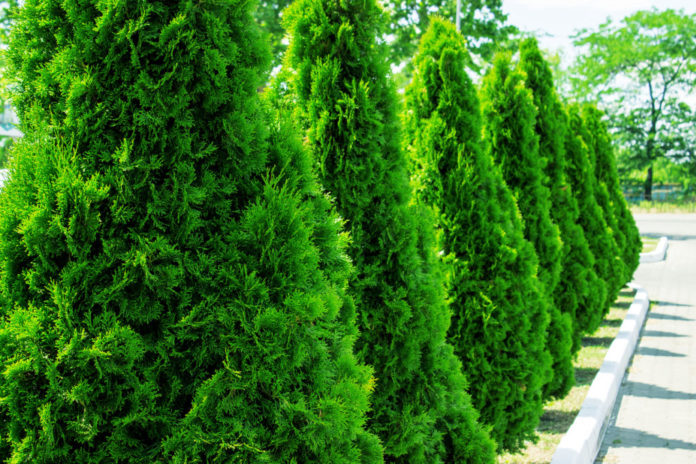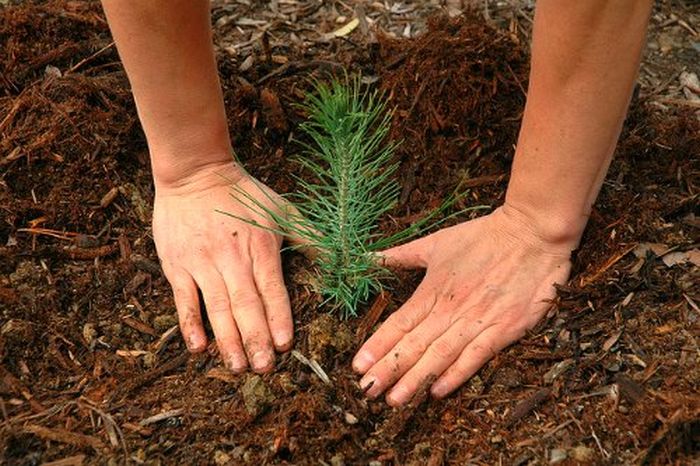
Evergreen Trees add year-round color and texture to the home landscape. You have a variety of choices from big to small and broadleaf to the needle. You can design just about any look in just about any yard with Evergreen Trees. Create privacy hedges, green screens, windbreaks, sound barriers, and specimens and group plantings. There are even evergreen trees small enough for containers, mixed beds, and foundation and anchor plantings. These trees are versatile and add visual interest to a barren winter landscape.
Evergreen Trees are low maintenance and drought tolerant once established and often perform well in poor soils. This is because they are slowly processing nutrients all year, unlike deciduous trees who lose nutrients when they shed their leaves and take a break all winter. Evergreen trees even reinforce their own survival and longevity by gradually and continually dropping leaves or needles that create the acid-rich soil in which they thrive.
How to Plant Evergreen Trees

-
- Research the Evergreen Tree you chose for your yard. Make sure it grows well in your growing zone. Determine the site requirements. Most Evergreen Trees prefer full sun and can adapt to just about any well-drained soil, but it is important to do a quick check to be sure you have the right environment for the tree.
- Dig a hole about twice the width and almost as deep as the root ball of the Evergreen Tree.
- Place the tree level in the hole. The root ball should be slightly above the existing soil line. Planting too deep can cause a tree to struggle and even die.
- Even before backfilling the soil, fill the hole with water. New trees like a lot of water. This ensures the roots are thoroughly wet and helps them establish properly and quickly. Happily established roots mean a happy established tree.
- Backfill the soil and tamp it down to remove air pockets. Do not stomp on the ground as it can compact the soil and make it harder for your tree to get established. If the soil is nutrient weak or heavy clay, the soil can be amended with some compost and/or potting mix, but be sure to keep at least 50% of the natural soil since this is what the tree must grow accustomed to ultimately.
- Mulch an Evergreen tree with 1 to 2 inches of mulch extended at least a few inches past the root zone or a tree canopy(whichever is larger). To make one, Backyardboss.net recommends using a woodchipper. Mulch helps the ground retain moisture and keeps competing weeds at bay. Do not pile up mulch against the trunk.
- Water again until the ground is fully saturated. Water deeply at the base of the tree at least twice a week for the first month and once weekly for months 2 and 3 while your tree is establishing. It is better for your tree and its roots for you to water heavily less often that just a little every day. We recommend using a hose with no attachments and just letting it run until the water starts pooling.
Evergreen Tree Spacing

Spacing From Home
To determine space from your home or building, look at the mature width of the chosen evergreen tree. Divide this in half for a pretty good spacing guesstimate. Add a foot or 2 if you want to be able to get behind the tree.
Privacy Screen Spacing
This easy formula works pretty well for privacy hedge spacing too, but it does vary depending on the angles of the trees and how well they tolerate being planted close together. Here is a list of common evergreen trees used for privacy – most of these you can find at PlantingTree.
Recommended Spacing for Privacy Trees
Blue Point Juniper: 5 to 6 feet
Carolina Sapphire Cypress: 6 to 8 feet
Cryptomeria Radicans: 8 to 10 feet
Emerald Green Arborvitae: 3 to 4 feet
Leyland Cypress: 5 to 10 feet
Nellie Stevens Holly: 5 to 6 feet
Oakland Holly: 6 to 8 feet
Sky Pencil Holly: 2 feet
Thuja Green Giant: 5 to 8 feet
Wax Myrtle: 5 to 6 feet
Specimen Tree Spacing
For spacing from individual tree to tree in the landscape when you want space in-between, use this formula for both trees; add them together, and then add a few feet for larger trees and about a foot for smaller trees.
















